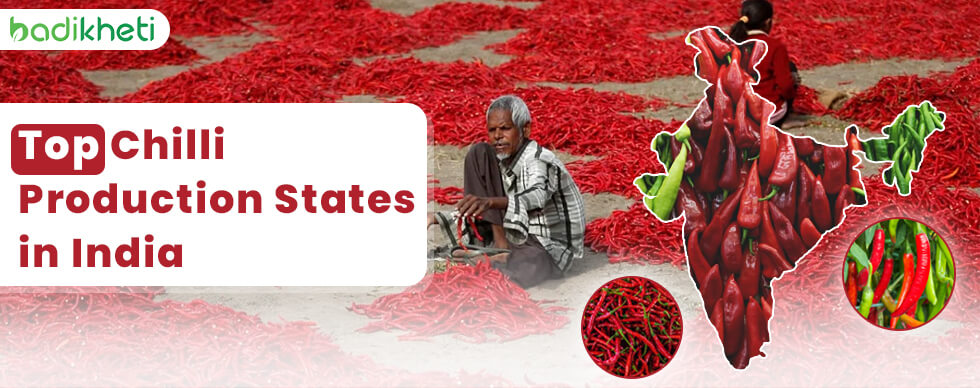
Chilli fondly known as “Mirchi” in Hindi holds great cultural and historical significance in India. It is not merely a culinary delight but an integral part of our traditions with significant links to agriculture and daily life. India takes great pride in being one of the leading producers and consumers of chillies globally, with various regions contributing to this spicy farming. This article aims to analyze the primary states involved in chilli cultivation within India, exploring their unique functions within the flourishing chilli industry.
Andhra Pradesh has garnered its rightful title as the “Chilli Bowl of India.” The district of Guntur, specifically, serves as a model for organic chilli seeds production. In this region, one can encounter diverse strains such as Guntur Sannam, Teja, and Byadagi that are acclaimed for their sharpness and caliber. Due to suitable weather conditions and resilient irrigation facilities, Andhra Pradesh is at the forefront of efforts towards the advancement of chilli farming.
Karnataka, with districts like Raichur, Gulbarga, and Haveri, proudly contributes to India’s chilli bounty. The Byadagi chilli, famed for its vivid red hue and mild heat, is Karnataka’s gift to the spice world. The state’s diverse climate, spanning semi-arid to coastal regions, fosters the cultivation of various chilli varieties, solidifying its position in the national spice market.
Tamil Nadu boasts a rich history of chilli farming, with districts like Dindigul, Madurai, and Krishnagiri taking center stage. The renowned Tamil Nadu 1 (TN-1) chilli variety, while not the hottest, is cherished for its vibrant red hue and versatility in a plethora of dishes. Tamil Nadu’s diverse agro-climatic conditions open doors to various chilli cultivations, adding to the spice’s charm.
Rajasthan, known for its arid landscapes, has surprised many as a budding chilli farming hub in India. Kota and Bundi districts shine with the cultivation of popular chilli varieties such as Bhut Jolokia and Sankeshwari chillies. The state’s arid climate, complemented by tube well irrigation, has paved the way for its ascent in the world of chilli farming.
Maharashtra has also etched its presence in the world of chilli cultivation, with districts like Sangli, Solapur, and Jalgaon taking the lead. The Indian state’s climate, marked by hot summers and moderate rainfall, provides the ideal backdrop for chilli growth. Varieties of chilli such as Dhani, Jwala, and Bhiwapur proudly represent Maharashtra in the spice spectrum.
Chilli seed germination and farming isn’t just agriculture; it’s a tapestry woven with diverse flavors and rich traditions across India. Andhra Pradesh, Karnataka, Telangana, Tamil Nadu, Rajasthan, and Maharashtra are the stars in this spicy constellation, each contributing unique chilli varieties and culinary treasures to the nation and the world.
If you are a farmer or a company looking to understand and embark on your own chilli farming adventure, buy chilli seeds online from a renowned online agriculture store as it much cheaper and further better processed from the regular agriculture store.
The Indian economy is based on agriculture, and the farmer's livelihood relies on the rain in monsoon season. But it isn’t certain, so depending entirely on it may affect soil management and agricultural yields. Crops need a proper quantity of water for their development. The only means our farmers can keep storing and using water properly is via irrigation. In this blog, we will understand the irrigation methods for excellent water management for Indian farmers. Undoubtedly, the world’s agricultural area has increased in the past,...
Spices constitute an essential element of Indian gastronomy, imparting richness, and piquancy to an array of recipes. Among them, a distinct position is held by chili peppers, which however face consistent threats from various diseases that can cause severe damage to crops. Disease-resistant chili seeds have lately emerged as a revolutionary alternative to safeguard chilli farming in India. This write-up explores the prospective benefits of these types of chilli seeds and their significant impact on the future of Indian spice agriculture. The predicament of diseases...
To cultivate organic winter crops successfully, it is of utmost importance for the farmer to adopt a systematic approach. This requires the farmer to play the dual role of both a custodian and a practitioner. To achieve a flourishing winter harvest, several recommendations have been proposed based on practical experience and tailored to facilitate effective rabi season vegetable cultivation within India's agricultural framework. Moreover, the foremost of all the benefits of growing organic vegetables is that it restores the ecosystem as well as is a...